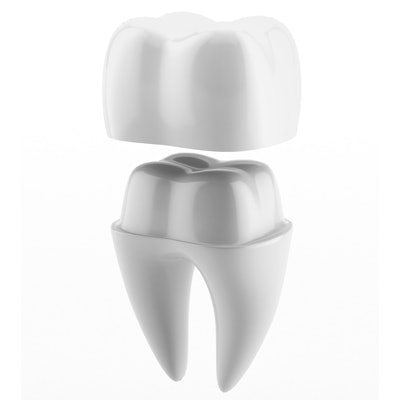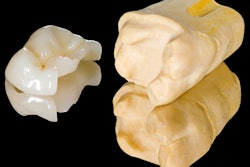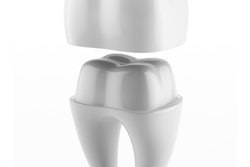
As two-piece implants have become standard, adherence of the crown to the abutment is critical for implant success. Researchers tested four different CAD/CAM implant-supported crown materials to measure their retention values and found cobalt-chromium crowns offered the most resistance.
Researchers evaluated the pullout resistance of four crown materials (temporary acrylic resin, zirconia, titanium, and cobalt-chromium) cemented onto titanium-base abutments. Their tests showed that cobalt-chromium had the highest resistance. Their study was published on July 2 in the Journal of Prosthodontics.
"Cobalt-chromium and titanium presented higher levels of retention to titanium-base abutment after being cemented," wrote the authors, led by Adolfo Coelho de Oliveira Lopes, DDS, of the department of prosthodontics and periodontology at the University of São Paulo Bauru School of Dentistry in Bauru, Brazil.
Pullout testing
Implants can be retained via screw or cement. The advantages of cement retention are aesthetics, passive fit of the crown, and the potentially improved load distribution during function, according to the authors. However, it can be difficult to remove excess cement from the gingival sulcus, which could lead to peri-implant soft-tissue inflammation.
In this study, the researchers wanted to evaluate the pullout resistance of CAD/CAM implant-supported crowns cemented with provisional and definitive cements on titanium-base implant abutments.
They fabricated 60 maxillary central incisor crowns in CAD software from a single stereolithography (STL) file (Ceramill Mind design software, Amann Girrbach) for use in titanium-base implant abutments and divided them into four groups by material used (15 per group):
- Temporary acrylic resin (VIPI)
- Cobalt-chromium alloy
- Polycrystalline zirconia
- Titanium
The researchers cemented the crowns in a specially designed "handle" that provided the attachment for the pullout testing and then left them to sit for 24 hours. They then subjected the crowns to the pullout test in a universal test machine at a 1.0 mm/min crosshead speed. The tests were done first without cement to evaluate frictional resistance, then with provisional cement (RelyX Temp NE, 3M), without cement again, and finally with resin cement (RelyX U200 self-etching resin cement, 3M).
Data evaluation as a function of cement type demonstrated the superiority of resin-based cements relative to provisional and baseline groups (p < 0.01). While cobalt-chromium crowns presented the highest pullout retention values, polycrystalline zirconia showed the lowest values (data in table below adapted from study).

Conclusions
The authors noted this was an in vitro study.
However, based on the study results, they came to the following conclusions:
- Both crown material and cement type influenced the pullout resistance of CAD/CAM implant-supported crowns on titanium-base implant abutments.
- Self-adhesive resin cement exhibited superior behavior when compared with temporary cement.
"The results showed that, depending on the crown material, differences in crown pullout resistance may occur even when similar milling parameters are used," the authors wrote.



















